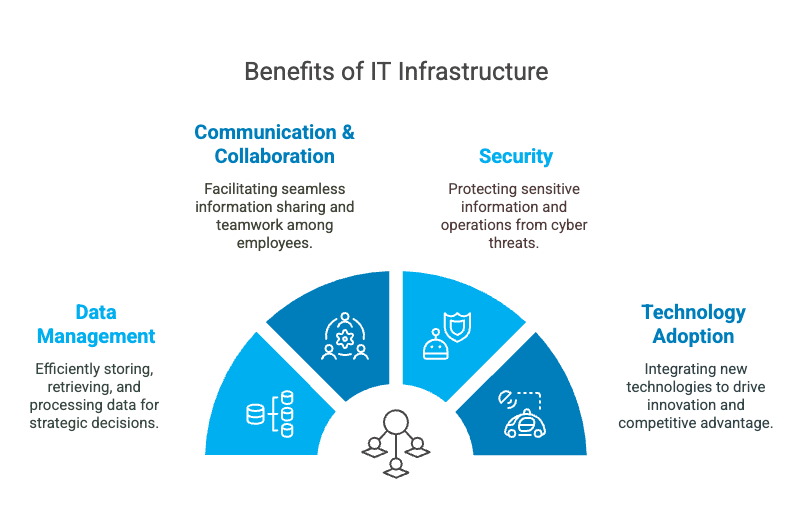Information technology (IT) spending is a vital and indispensable investment that can satisfy the business needs of organizations across industries. Consequently, having a robust and efficient IT infrastructure (technology infrastructure or IT environment) is crucial for achieving operational success and longevity.
But a company’s IT environment is only effective if it is configured correctly and updated regularly. This comprehensive guide will look into what an IT infrastructure is (and its individual components) and how to build an effective technical ecosystem with best practices.
IT infrastructure: A simple definition
IT infrastructure includes the hardware, software, networks, and services that allow users to access and leverage company data and tools. It forms the backbone of an organization’s technology ecosystem, enabling the flow, storage, processing, and security of information.
Technology infrastructure takes two forms:
- Cloud infrastructure: When technologies and data are hosted in the cloud (a digital space whose products and services are accessed using an Internet connection).
- Traditional infrastructure: When resources are hosted on-premises or in a local data center.
With a cohesive set of business IT solutions powering their operations, companies can streamline their workflows and achieve business objectives.
Why do businesses need a technology infrastructure?
Organizations need information technology infrastructure for several reasons, including the following:
- Facilitates efficient data management: An IT environment allows companies to store, retrieve, and process vast amounts of information. This can ensure that business leaders and employees have the right data to make strategic decisions, quicken processes, and enhance overall productivity.
- Promotes effective communication and collaboration: With business IT solutions such as unified communications and collaboration platforms, employees can easily share information, work on projects together, and coordinate tasks more efficiently.
- A secure environment for data storage and workplace processes: An IT environment should contain the latest cybersecurity solutions to safeguard sensitive information/operations from security threats, such as unauthorized access or out-of-date software.
- Easier time leveraging emerging technologies: A robust technology infrastructure is equipped to readily adopt the latest business IT solutions to drive innovation and agility for a greater competitive advantage.

A deeper look at the components of an IT infrastructure
Effective technology infrastructure is composed of several interconnected components that work together to support the overall organization.
They include the following:
- Hardware: This includes servers, network devices, and other physical resources that allow users to access data and applications.
- Software: Applications and programs (such as operating systems, databases, productivity suites, etc.) that support different functions.
- Networks: This covers Internet connection, routers, switches, and other communicative tools that connect devices within local area networks (LAN). These components enable communication and data transfer.
- Data centers (or server rooms): Secure hubs for housing hardware, software, and network tools.
- Cybersecurity: The software tools that protect business IT solutions. Cybersecurity also extends to physical safeguards and general cyber safety practices.
For cloud infrastructure, cloud computing solutions (for example, infrastructure-as-a-service or IaaS tools, software-as-a-service or SaaS solutions, and more) form the meat of the IT environment. The aforementioned components allow users to access them.
How to build an effective IT environment
Building a resilient IT infrastructure requires a systematic and strategic approach to ensure that the technology you implement aligns with your organization’s goals and supports its operations.
By following these steps, you will create a technology infrastructure that drives efficiency, productivity, and seamless technology integration.
1. Assess business needs
Evaluate your company’s current and future IT requirements and how they relate to your goals. Consider factors like:
- Scalability for seamless operational growth
- Increased data storage to accommodate a growing customer base.
- Stronger networking capabilities to support remote work.
- The types of software you and your team need to carry out your jobs.
An assessment provides you with an opportunity to locate process inefficiencies. Knowing where (and why) your company needs technology will help you choose the right business IT solutions at the start of the building stage.
2. Plan your IT infrastructure’s architecture
Create a comprehensive plan outlining the hardware, software, and networking components needed to meet your business needs. Make sure that every tool and service that makes up your technology infrastructure is compatible with each other. Also, IT compliance is absolutely vital for businesses. So, you should check that each solution you invest in is compliant with all necessary regulations.
3. Choose reliable vendors
Study all the IT vendors in the market—companies that supply hardware, software, and networking solutions. Research their track record and compatibility with the IT environment you want to create. Only go with a vendor that demonstrates reliability, expertise, and a strong alignment with your IT (and business) goals.
4. Prioritize security
Protecting your technology against network security threats should be a major priority. Incorporate strong security measures from the beginning. This includes data encryption, intrusion detection systems, endpoint protection, and more. Additionally, establish an assessment schedule to ensure all areas of your IT environment are up to date with the latest security patches.
IT infrastructure: Best design, implementation, and maintenance practices
There are a few practices that businesses can use to ensure that their technology ecosystem remains robust, reliable, and aligned with their industry’s standards.
Design tips
- Keep things simple: Avoid any unnecessary additions or connections that will complicate the IT environment.
- Engage with your team: Asking for your employees’ input will result in a more effective and tailored IT infrastructure that satisfies all needs.
- Keep the future in mind: Make sure your technology infrastructure has the means to integrate with future business IT solutions, allowing your IT ecosystem to grow with your organization.
Implementation and maintenance tips
- Create an implementation plan: A deployment strategy offers businesses a structured guide to follow when rolling out business IT solutions, increasing the chances of a smooth implementation.
- Create a disaster recovery plan (DRP): Develop a DRP to ensure that systems are restorable in the event of a disruption. Test the plan periodically to ensure its effectiveness and make necessary adjustments.
- Acquire the assistance of a managed service provider (MSP): An MSP can help companies build, deploy, and manage IT environments to ensure success.
Harness the full power of technology with cost-effective managed services
A well-designed and maintained IT infrastructure enables organizations to adapt to changing market demands, securely manage data, and leverage technology to achieve their strategic goals.
Davenport Group’s managed services specialists are experts in designing, setting up, and maintaining business IT solutions that result in highly efficient, secure IT infrastructures.
The team at Davenport Group can assess your business needs, develop a comprehensive IT environment that fulfills your requirements, and deploy it with minimal disruption to your company processes. Additionally, their ongoing IT infrastructure management and support services can ensure your organization experiences uptime 24/7/365.
If you are looking to build a technology infrastructure that propels your business forward, contact Davenport Group today.
